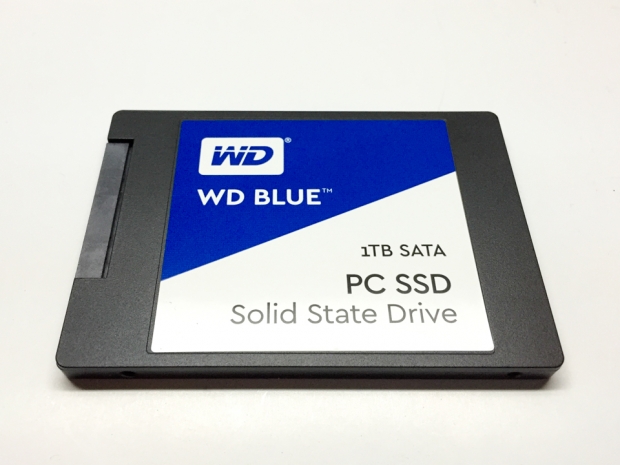Index
Similar to SanDisk X400, but may need pricing adjustment
Western Digital is a company with a rich history in developing hard disk technologies that have become widely adopted since the era of floppy disk formatters/controllers and the ATA interface.
After the company bought Siliconsystems Inc. in mid-2009, it indicated an interest in expanding its traditional disk drive industry into the solid-state storage market, giving it the means to form the WD Solid-State Storage Business.
In May 2013, the company released its first solid-state hybrid drive, the WD Black SSHD, featuring NAND flash from SanDisk between 8GB and 24GB in capacity, with performance up to 450MB/s reads and 350MB/s writes. The drive also offered a SATA III 6Gbps interface for storage, using firmware to determine caching to the solid-state storage module.
After announcing its plans to acquire SanDisk last fall and completing the acquisition for $19 billion earlier this year, the company is now ready to introduce its first self-branded solid state disks to consumers based on the SATA interface in 2.5-inch and M.2 2280 form factors.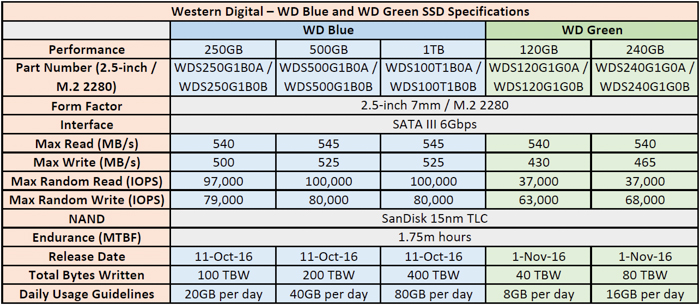
WD Blue and Green
The company is releasing two lineups for its first self-branded SSDs, WD Blue and WD Green. The WD Blue series drives are optimized for multitasking performance and resource-heavy applications, offering up to 545MB/s reads and 525MB/s writes with up to 400TBW endurance. On the other hand, WD Green series drives are more power-efficient and feature up to 540MB/s sequential reads and 405MB/s sequential writes with up to 80TBW endurance.
The WD Blue series is available in 250GB, 500GB and 1TB capacities and in both 2.5-inch and M.2 2280 form factors, with suggested retail prices of $79, $139 and $299, respectively. Meanwhile, the WD Green series is available in 120GB and 240GB capacities also in both 2.5-inch and M.2 2280 form factors, with prices yet to be announced. The WD Blue series is now shipping, while the company has said WD Green will become available sometime later this quarter.
WD Blue
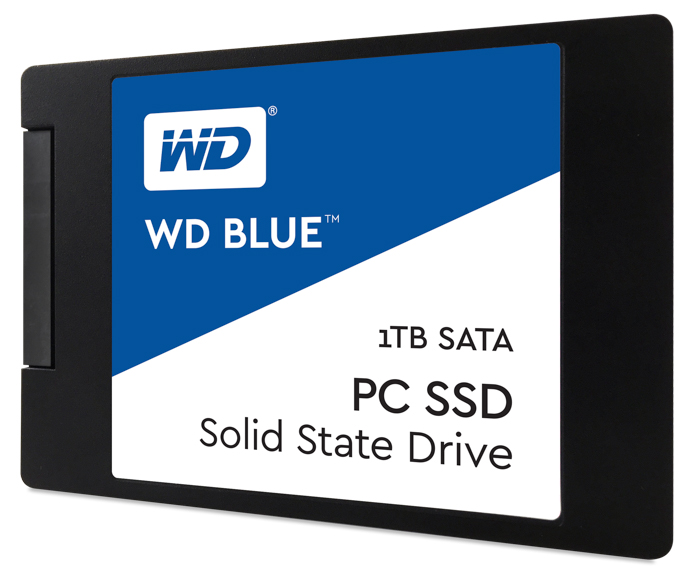
This review focuses on the WD Blue, including listed features, performance specifications and benchmarks. According to the company’s product manual, these drives are designed for high endurance scenarios with heavy workloads ranging between 40GB and 80GB per day of written data.
Packaging and specifications
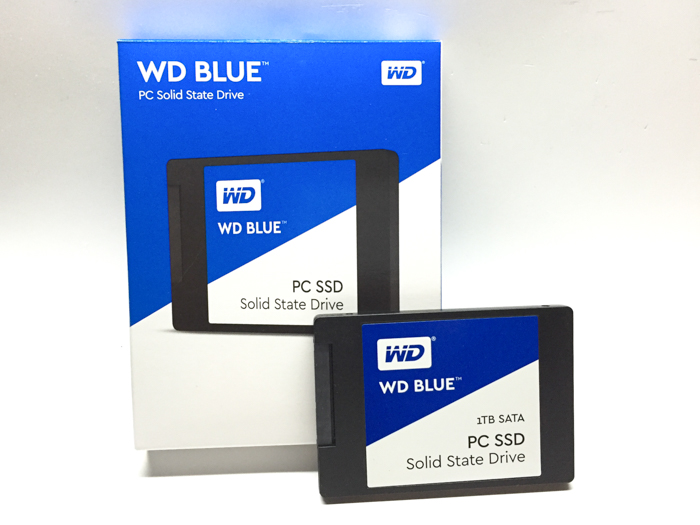
The WD Blue 1TB 2.5-inch SATA III solid state disk provided by Western Digital comes with white and blue packaging that shows drive size and warranty information on the front, and model number and form factor on the back.
The packaging also classifies the company’s storage products into four segments – WD Blue for mainstream PCs, WD Black for performance PCs, WD Red for NAS devices, and WD Purple for surveillance.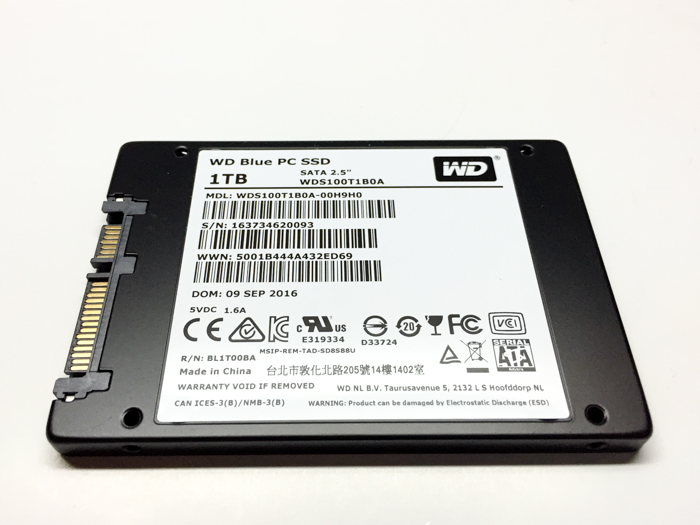
The WD Blue and WD Green are the company’s first SSD products since it acquired SanDisk, and as such it has not made any announcements yet for the other segments. The prospects for additional WD-branded flash memory products will result from the initial market response and sales numbers moving into the next several quarters. It is possible that more SSD products may be announced at CES in just a few months or even Computex in the summer, but this will depend on company strategy, reaching the right price-to-performance targets, and meeting any related NAND flash supply levels going forward.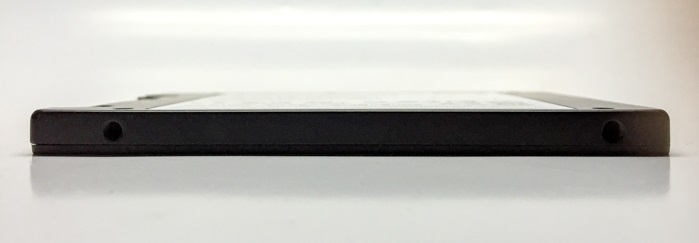
The 2.5-inch SATA III version of the drive measures 7mm thin by 69.85mm wide by 100.2mm tall (0.28 x 2.75 x 3.94 inches) and is rated at 70mW of average active power, 4.9mW to 9.7mW in devSlp (Device Sleep) mode, and 42mW to 52mW in Slumber mode.
Operating temperature ranges between 0C and 70C, and the drive is rated with a mean-time before failure (MTTF) rating of 1.75 million hours, or about the same as SanDisk’s X400, Ultra II, SSD Plus and Z410. It can be noted that Micron’s M510DC and M500DC and Corsair’s Force GS series are rated at 2 million hours, but the number is not always indicative of actual performance and may vary depending on workload type and gigabytes of throughput per day consumed by the user.
Marvell 88SS1074 controller with SanDisk NAND modules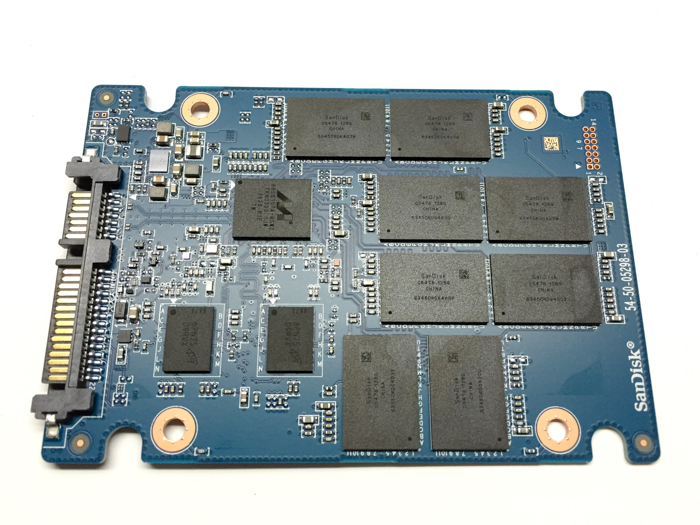
The WD Blue series features eight SanDisk second-gen 15nm TLC NAND flash modules along with a small SLC cache that allows for on-chip data transfer from SLC cache to the TLC modules. Just like the SanDisk X400, the drive also uses Marvell’s 88SS1074-BSW2 four channel controller and features a 28nm CMOS process, support for low-power mode including DevSlp, ONFI 3.0 and AES 256 encryption, and low-density parity check (LDPC) error correction.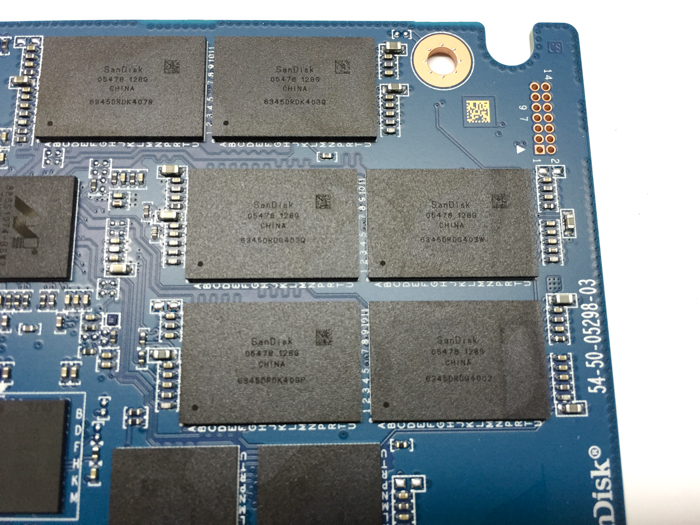
The LDPC feature is important because it ensures proper on-the-fly error correction and is designed to have a minimal impact on latency and performance while maintaining low power usage.
Supports multi-stream for lower write amplification
A more advanced yet recent feature included in this drive is multi-stream, which was introduced in the T10 standard in May 2015 and is featured in Samsung’s PM953S NVMe SSDs. Multi-stream is a way to preserve write-amplification by erasing blocks storing unique stream IDs at the same time. A stream is basically a group of individual write data that shares similar lifetime values prior to being erased. Each stream of write data is given a unique ID which is then sent to the same erase block instead of being scattered. By clustering data with similar lifetime values into erase blocks, an SSD can erase entire stream IDs at the same time while avoiding the fragmentation of traditional garbage collection routines that often lead to higher write amplification with time.
Image source: Samsung Semiconductor, Inc. at Flash Memory Summit 2016
Samsung has illustrated this technology particularly well in a presentation given at Flash Memory Summit 2016 in Santa Clara, showing how multi-stream SSDs can use efficient data placement to reduce garbage collection procedure overheads while improving performance and product lifetime.
In addition to multi-stream, the WD Blue also supports dynamic and static wear-leveling, bad block management and background garbage collection. Other features include S.M.A.R.T. commands, TRIM, and NCQ with queue depth 32.
Terabytes written (TBW) endurance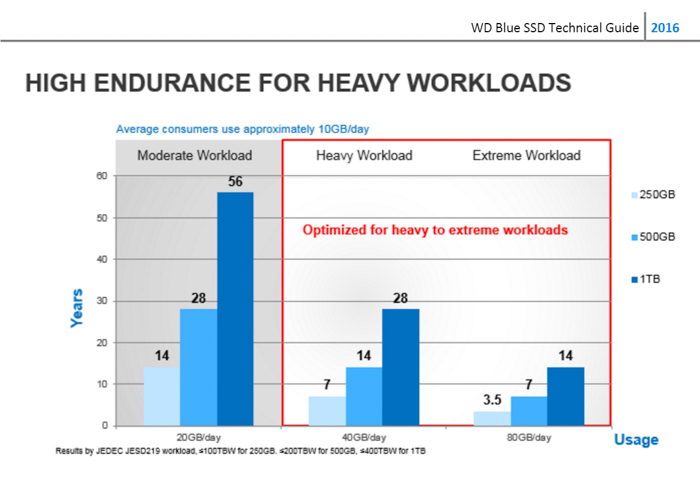
Western Digital’s technical supporting guide to reviewers notes that the WD Blue is designed more for heavy to extreme workloads, which can range anywhere between 40GB and 80GB per day. While an average consumer reading and writing approximately 20GB of data per day can expect 56 years out of the 1TB model with 400 terabytes written, the company’s target market with a minimum of 40GB written per day can expect 28 years, while users can expect a 14-year lifespan by writing either 20GB per day to the 250GB model or 80GB per day to the 1TB model.
Test setup
Our full test configuration consisted of an Intel Core i7 5820K CPU at 4.33GHz, an EVGA X99 Classified motherboard, 16GB (4 x 4GB) of Kingston HyperX DDR4 2800MHz CL14, a Samsung 840 Pro SSD as the primary drive, an EVGA SuperNOVA 750 G2 PSU and a Corsair Carbide Air 540 gaming case. The system was operating in a room temperature environment with side panels off, using an air-cooled Thermalright TRUE copper CPU heatsink, two Noctua heatsink fans and five Corsair case fans.
Warranty
The WD Blue solid-state disk lineup comes with a three-year warranty, and this is where the multi-stream write support and any additional firmware improvements in lower write amplification come into play. At 20GB per day, the warranty is enough to last around 22 terabytes written. At 40GB per day, this is around 44 terabytes written, and at 80GB per day this should be enough to last just under 90 terabytes written.
CrystalDiskMark
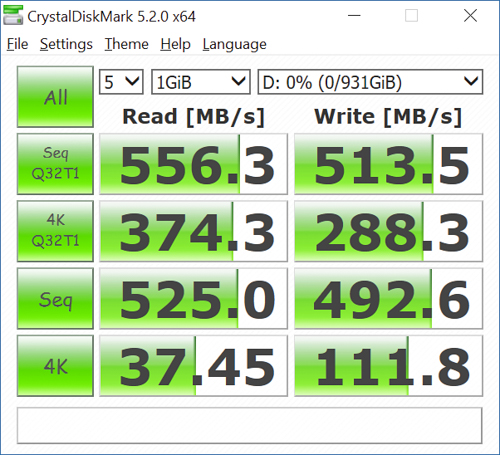
In our default 1GB random test, sequential read performance at QD32 jumps above the drive’s rated 545MB/s speeds to 556MB/s, while sequential writes come in below the rated 525MB/s spec at 513MB/s. Meanwhile, random 4K reads get 374MB/s while random 4K writes achieve 288MB/s, and the numbers for both sequential and random performance are still lower than the results from our OCZ Trion 150 480GB review. Both drives are using 15nm TLC NAND flash, with the main difference being that the Trion 150 uses a Toshiba controller while the WD Blue uses a Marvell controller.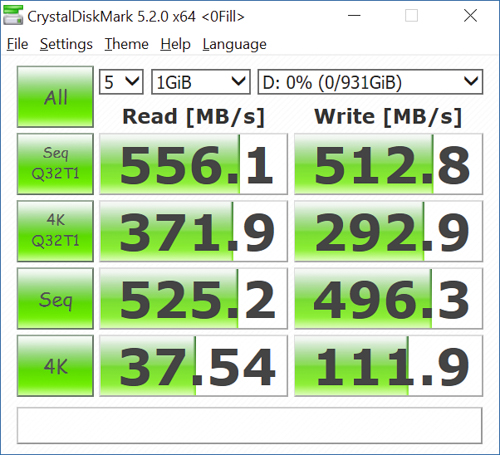
In the 1GB 0Fill test, the drive performs very similarly across the board with a small margin of a few megabytes per second in each category, though sequential read performance is still above the rated 550MB/s specification.
ATTO Disk Benchmark
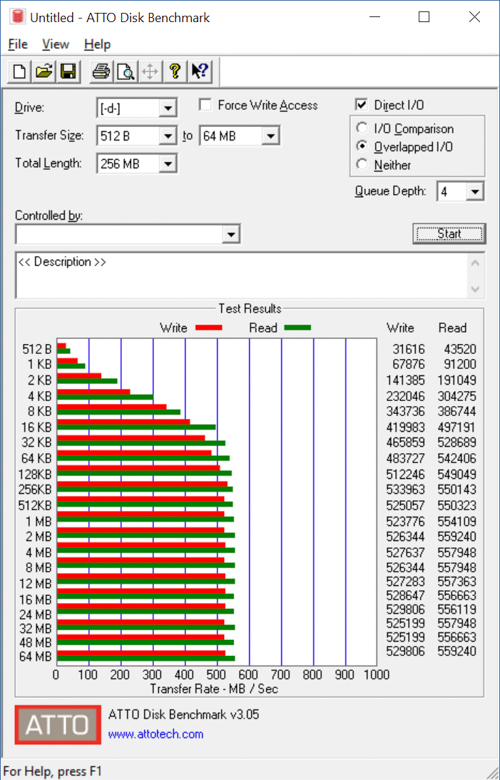
In our ATTO Disk Benchmark test, the WD Blue 1TB SSD delivers very consistent performance between 128KB and 64MB file transfers, making this drive particularly useful for workload environments where users need to consistently transfer large files such as media, compressed file formats and databases, to name a few scenarios.
The drive tops out at 559MB/s read speeds for 2MB files and 534MB/s write speeds for 256KB files, both of which are above the rated 545MB/s sequential read and 525MB/s sequential write specs. The drive still does not quite approach the 600MB/s limitation of the SATA III interface, though we have yet to see any TLC NAND drive capable of doing this for now. The M.2 version of this drive is rated at the same speeds and also uses the SATA III interface, so there should be little to no performance difference between the two form factors in regards to SATA 6Gbps standard limitations.
Iometer
For our Iometer test, we decided to test 4K random read and write workloads at 100 percent using all of the 1TB drive’s available storage space. We then applied a 10 percent over-provisioning on partition size to see if this would result in any random workload performance gains.
Over-provisioning is a technique that allocates a set amount of spare area on the drive to give the controller more room to perform garbage collection routines, often giving higher random read and write performance in some situations but making no difference in others. Some manufacturers employ this technique right out of the box, offering consumers 480GB and 960GB drives instead of the full 500GB and 1TB capacities.
More specifically, we wanted to test over-provisioning with the WD Blue 1TB to see if it provides any performance benefit on top of the drive's use of multi-stream commands, which reduce write amplification over traditional garbage collection methods.
Iometer (4KB, 100% read) – No added over-provisioning
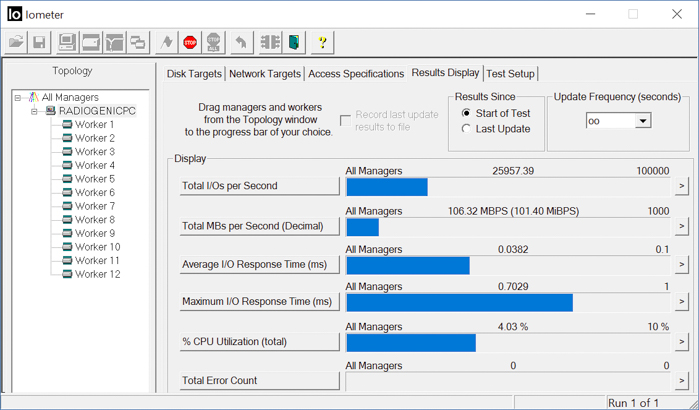
The default results for 4KB random reads at 100 percent show 106 total MB/s and 25,957 total IOPS at 0.03 percent average response time, with 4.03 percent CPU utilization during this test
Iometer (4KB, 100% read) – 10 percent over-provisioning
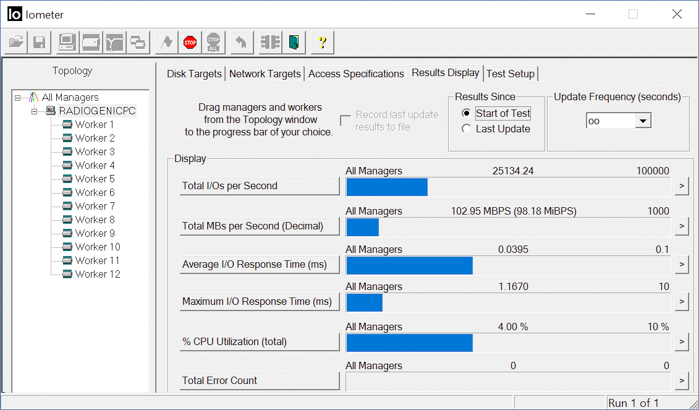
The 10 percent over-provisioned results show 102.95 total MB/s and 25,134 total IOPS at 0.04 percent average response time, with 4 percent CPU utilization during this test.
Iometer (4KB, 100% write) – No added over-provisioning
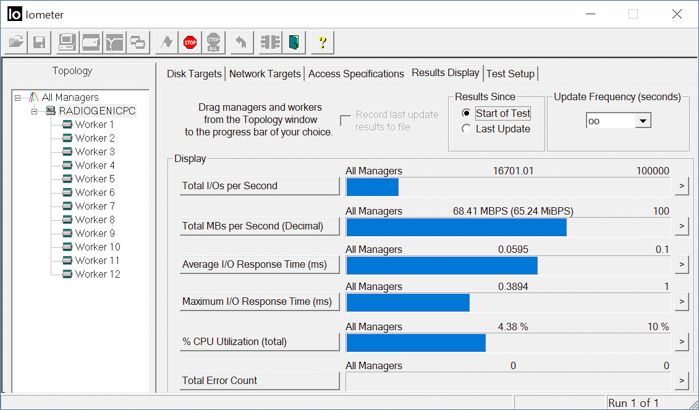
The default results for 4KB random writes at 100 percent show 68.41 total MB/s and 16,701 total IOPS at 0.06 percent average response time, with 4.38 percent CPU utilization during this test.
Iometer (4KB, 100% write) – 10 percent over-provisioning
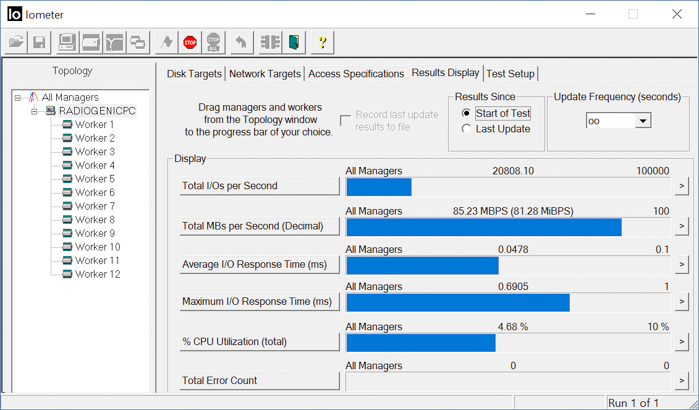
The 10 percent over-provisioned results show 85.23 total MB/s and 20,808 total IOPS at 0.05 percent average response time, with 4.68 percent CPU utilization during this test.
According to the results, freeing up 10 percent of partition space on the drive can improve 4K random write performance by about 12.5 percent, which isn’t too high of a performance margin but can still help for those willing to shed about 95GB of free space for the sake of sustained small file workloads. Of course, this would require a very specific usage scenario and does not apply to everyone.
AS SSD
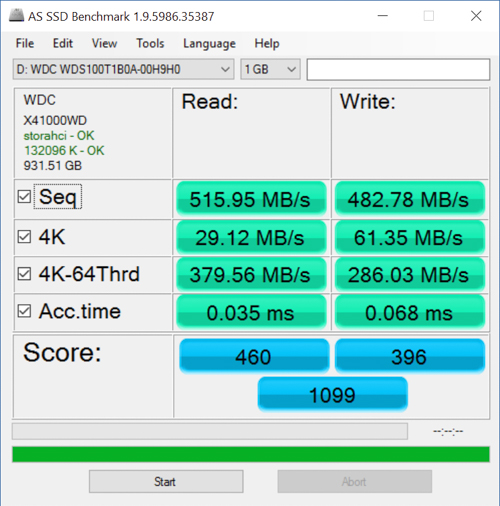
According to our AS SSD benchmark test, the WD Blue 1TB SSD gets a score of 1099 with 515.95MB/s sequential reads, 482.78MB/s sequential writes, 29.12MB/s 4K reads and 61.35MB/s 4K writes. At QD64, the 4K reads are 379.56MB/s and 4K writes at 286.03MB/s.
These results are interesting when put up against the OCZ Trion 150 480GB we reviewed earlier, which had a total score of 857. The drive outperformed the WD Blue in sequential read performance at 529.47MB/s and random 4K reads at 42.68MB/s, yet underperformed at 4K QD64 reads at 155.85MB/s.
Price-per-gigabyte
Most drives in the 1TB SSD market these days have a starting price around $200 on the lower end and can reach about $400 or higher depending on purchase date and any additional markup by the retailer.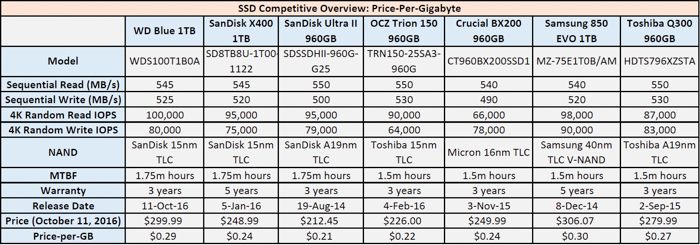
SSD Competitive Overview: Price-Per-Gigabyte (Larger image here)
In terms of pricing, the 2.5-inch version of the WD Blue 1TB SSD can be found at Newegg at the MSRP price of $299.99, while the M.2 version is available for $319.99. Amazon has the 2.5-inch version listed for $279.99, but they will not ship it until early November, so we are using Newegg’s price as a reference in our charts. The same goes for B&H, MacMall and TigerDirect, among others.
Our chart lists some of the highest performing solid state drives over the past 30 months, with the SanDisk Ultra II 960GB coming in at a low $212.45 ($0.21 per-gigabyte), followed by the OCZ Trion 150 960GB at $226, and the SanDisk X400 1TB and Crucial BX200 960GB at $248.99 and $249.99, respectively. There is a noticeable $30 price jump to the Toshiba Q300 at $279.99, while at the top of the list are the WD Blue 1TB and Samsung 850 EVO 1TB with similar prices of $299.99 and $306.07, respectively.
Dynamic SLC caching
All of the drives listed in this chart feature SLC caching in one form or another, which allows small temporary amounts of data to be read to and written from DRAM much faster before being stored in the larger TLC NAND flash blocks.
SanDisk’s X400 and Ultra II drives both use advanced flash management features including nCache 2.0, multi-page recovery, XOR recovery and “on chip copy” that uses up to 40GB of SLC storage on the 960GB model to read and write files of any size. In the past, this feature was limited to small 4KB file writes and just 1GB of space on the Ultra Plus series. Samsung’s 850 EVO 1TB and Crucial’s BX200 also use a similar pseudo-SLC caching layer that allow much higher write performance in short bursts, which are handled by their respective Silicon Motion SM2246EN and Samsung MEX controllers. Toshiba calls its form of SLC caching “adaptive size SLC write cache technology,” while OCZ’s implementation is called “Performance Mode” and allocates 1.5 percent, or 14.5GB of storage on the 960GB model as an SLC-like buffer that significantly improves sustained transfer speeds for large datasets.
Western Digital’s implementation is called “tiered SLC caching” and will give the same result, improving sustained write performance for large files as long as the data fits into the SLC cache size.
Western Digital's entrance into SSD market
Western Digital has come a long way since the early 1970s when it was the largest independent calculator chip maker in the world, as well as a manufacturer of Pascal programming language microcomputer products and single-chip floppy drive controllers. Since then, the company has been a key player in developing hard disk controllers that have led to newer technologies such as the first 2TB SATA drive using perpendicular magnetic recording, to helium-filled drives in 6TB and higher capacities.
With the introduction of WD Blue and WD Green solid-state disk lineup, it is showing interest in not only becoming a key player in the SSD business, but also in complementing its existing lineup of workstation and enterprise hard disks with the new technologies and features it acquired in its SanDisk purchase last Fall.
Warranty
While the company offers 2-year warranties on its WD Blue hard drives and 5-year warranties on WD Black hard drives, it is offering a 3-year warranty on its WD Blue solid-state disks. As mentioned earlier, this is enough to last around 22 terabytes written at 20GB per day, 44 terabytes written at 80GB per day and just under 90 terabytes written at 80GB per day.
The WD Blue 1TB SSD includes a total terabytes written (TBW) rating of 400, still higher than the other drives included in the price-per-gigabyte chart, though some of them include 5-year warranty ratings.
Performance
While the OCZ Trion 150 960GB gets higher sequential speeds overall in our tests, the WD Blue is notable for its 4K read performance at QD32 and QD64. At these queue depths, the drive is almost two and a half times faster than the Trion 150 but only for read speeds, making it useful in particular situations but still trailing behind in random and sequential write performance. This may be attributed to the drive’s 100,000 IOPS 4K random read rating, while the Samsung 850 EVO is rated at 98,000, followed by the SanDisk X400 and Ultra II at 95,000.
On the positive site, this is one of the first drives along with Samsung’s PM953S NVMe SSD to support multi-stream writes, which is a way to reduce write-amplification by erasing blocks with unique stream IDs at the same time. This can help reduce the fragmentation of traditional garbage collection routines and improve the lifespan of the drive, which is likely a contributing factor to its higher 400 TBW rating.
The drive also managed to outperform its rated 545MB/s sequential read spec in CrystalDiskMark at 556MB/s, and in ATTO Disk Benchmark going up to 559MB/s. Meanwhile, sequential writes were at the rated 525MB/s in ATTO Disk Benchmark but were slightly below spec in both AS SSD and CrystalDiskMark tests at 483MB/s and 513MB/s, respectively.
Conclusion
The WD Blue 1TB is available at Newegg for the manufacturer suggested price of $299.99, which seems a bit high for a launch price when competitor products such as the OCZ Trion 150 960GB can now be purchased for $226. But it seems the company is targeting the Samsung 850 EVO 1TB, as this drive offers higher 4KB random read and write speeds and is currently priced at $306.07.
On the other hand, the WD Blue 1TB is more similar to the SanDisk X400 1TB based on other reviews. The main difference between the WD Blue and SanDisk X400 seems to be that one has a higher endurance rating and uses different firmware, as both are using the Marvell 88SS1074 controller. All in all, the WD Blue will need to be priced lower than MSRP in order to account for the additional write endurance rating, and it is possible this will happen as the TLC NAND flash market begins adjusting to having another industry player in the SSD market.

